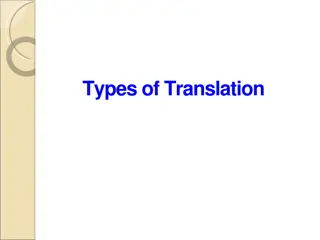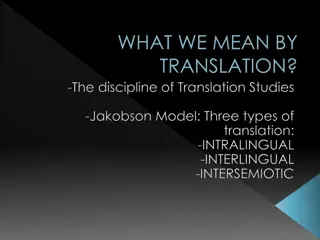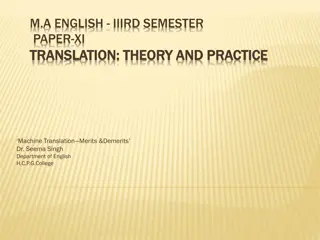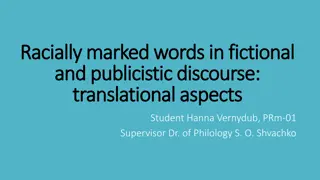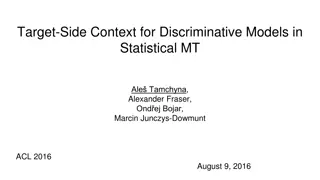Strategies for Information Structure in English to Spanish Translation
Discussing the challenges and strategies of information structure in translating from English to Spanish, focusing on maintaining the Information-Flow Principle and adapting to the different syntactic patterns of both languages. Passive voice usage and its impact on information presentation are explored, emphasizing the importance of maintaining coherence in discourse.
Download Presentation

Please find below an Image/Link to download the presentation.
The content on the website is provided AS IS for your information and personal use only. It may not be sold, licensed, or shared on other websites without obtaining consent from the author. Download presentation by click this link. If you encounter any issues during the download, it is possible that the publisher has removed the file from their server.
E N D
Presentation Transcript
INTRODUCTION GOAL: to discuss information structure (IS) strategies that may be used in the field of translation , more precisely in translating from English to Spanish. Jimenez- Fernandez (2020) observes that many problems arise in translation when setting the theme/topic in the target language. This is particularly problematic when English is translated into Spanish, since English is a very rigid language in that it basically makes use of the SVO word order in all discourse situations, whereas Spanish is much more flexible and allows other patterns such as SVO, OVS, VOS, VSO for information structure reasons. In the light of this, it is extremely important to use similar discourse strategies to present the same message in exactly the same terms from an information-structure point of view (Dejica 2009). This means that the syntactic configurations may be different in the source and target texts. one such case is passive. In English, the passive is much more productive than in Spanish. Even if this is the case, the proposed translation may possibly respect the topic-focus partition, thereby satisfying the Information-Flow Principle (Prince 1981), according to which the syntactic ordering of a sentence moves from given-to-new information.
SOME BACKGROUND ON INFORMATION STRUCTURE The organization of the message is ruled by the Information- Flow Principle which is related to the normal ordering of information in discourse both in English and Spanish, moving from given to new information. 1. Where did you see Peter? a. I saw him in the supermarket. b. In the supermarket I saw him. 2. Who did you see in the supermarket? a. I saw Mary in the supermarket. b. In the supermarket I saw Mary. Sentences involve a double articulation with respect to the information they convey. Given and known information is given at the beginning, whereas new and comment-related information is provided at the end. Syntax offers a series of formal mechanisms which help us in delivering the message we want to convey.
FOOD FOR THOUGHT Identify the passive structures in the following extract and determine its discourse function. Renewable energy is energy derived from natural source that are replenished at a higher rate than they are consumed. Sunlight and wind, for example, are such sources that are constantly being replenished. Renewable energy sources are plentiful and all around us. (What is renewable energy?. United Nations. Recuperado de: https://www.un.org/en/climatechange/what-is-renewable-energy) Las energ as renovables son un tipo de energ as derivadas de fuentes naturales que llegan a reponerse m s r pido de lo que pueden consumirse. Un ejemplo de estas fuentes son, por ejemplo, la luz solar y el viento; estas fuentes se renuevan continuamente. Las fuentes de energ a renovable abundan y las encontramos en cualquier entorno. ( Qu son las energ as renovables?. United Nations. Recuperado de: https://www.un.org/en/climatechange/what-is-renewable-energy)
INFORMATION STRUCTURE OF PASSIVES One important discourse function of passives is to accommodate information structure by presenting information from given to new. Most frequently, the subject contains given information while the agent (when explicit) presents new information, which means that the subject in passives has a higher level of givenness than the agentive phrase. 3. What causes so many diseases in Brazil? a. Most diseases are caused by mosquitoes. b. # Mosquitoes cause most diseases.
Passives can also help to keep the topic continuous so that the discourse is coherent. For example: 4. The town is a major attraction for tourists and (the town) is surrounded by natural countryside housing a lot of wildlife. 5. The town is a major attraction for tourists and natural countryside housing a lot of wildlife surrounds it. A different discourse function can also be developed by passives, namely broad focus. This means that the sentence is new information. The passive can fulfil this function in both languages. For example, in an out-of-the blue context: 6. Full payment will be required upon reservation. In this case there is no partition of information in this sentence since it is topicless. The most natural equivalent in Spanish would be a passive se construction which follows VS word order. 7. Se requerir el pago total a la hora de reservar.
PROBLEMS FOR THE FIELD OF TRANSLATION The problem for the field of translation lies in that sometimes the IS of the original text is not preserved leading to an informative mismatch between the original and the target message. It is extremely important to use similar discourse strategies to present the same message in exactly the same terms from an information-structure point of view. This may mean that the syntactic configuration will be different in the source and target texts. In English the passive structure is more productive and in Spanish the passive se or CLLD constructions are used instead. In a context where we already have information about bread, this is eligible as a topic in a passive sentence: 8. From my barrack-room alone, a basketful of bread was thrown away at every meal. (from Orwell s Homage to Catalonia, p.10) However, the Spanish passive is hardly natural in the same context, and we usually find the use of the active counterpart. 9. En nuestro barrac n solo, una canasta de pan era tirada en cada comida. 10. En nuestro barrac n solo, tiraban una canasta de pan en cada comida. Ideally, the translation should preserve the IS of the original text selecting a basketful of bread as the topic and highlighting at every meal as the focus. In order to achieve that discourse effect, the following translation is suggested: 11. En nuestro barrac n solo, una canasta de pan se tiraba en cada comida.
POSSIBLE STRUCTURES IN SPANISH FOR THE PASSIVE IN ENGLISH Syntactic and semantic properties: Consider the following examples of Spanish structures equivalent to the passive construction in English and match the structures with the corresponding characteristics presented in the chart below. 1. Se vende un departamento de dos ambientes. 2. El departamento de dos ambientes se vendi ayer. 3. Se nombraron nuevos delegados. 4. Se rompieron las ventanas deliberadamente/con alevos a. 5. Se rompieron las ventanas para cobrar el seguro. 6. Se rompieron las ventanas (?? por los ni os/*por juan). 7. El edificio fue construido en 2011 por el arquitecto Martinez. 8. Los departamentos fueron vendidos por la inmobiliaria. 9. ?? Fueron vendidos los departamentos por la inmobiliaria. 10. El auto fue incendiado por el propio due o para cobrar el seguro. 11. A tu primo lo vi ayer. 12. Esta plaza la cuidan Aerol neas Argentinas y usted. 13. * A esta plaza cuidan Aerol neas Argentinas y usted.
Syntactic and Semantic properties The element that surfaces as subject is the internal argument (object). It can be pre or post verbal. Passive se Periphrastic passive CLLD The object that is the topic appears dislocated to the left of the sentence and it is necessariy doubled by a clitic pronoun. The element that surfaces as subject is the internal argument (object) and must be preverbal This structure allows, in principle, markers that involve the presence of an agent (implicit agent) whose interpretation is arbitrary. In this structure there is a definite, specific agent. These structures are compatible with agent-oriented adverbs These constructions are only possible with transitive verbs.
POSSIBLE STRUCTURES IN SPANISH FOR THE PASSIVE IN ENGLISH PASSIVE SE: MAIN PROPERTIES Passive se affects the clausal structure Passive se structures can be characterised, coarsely, by four properties: i. the first one is that passive se is interpreted as a passive in the sense that the argument that seems to be the subject is interpreted not as an agent but as an internal argument (object) that undergoes the event expressed by the verb. 12. a. Juan encontr muchas cosas en su casa. b. Se encontraron muchas cosas en su casa. ii. The passive se structure agrees in number with the internal argument, that becomes the subject. 13. a. Se encontr una cosa. b. Se encontraron muchas cosas.
POSSIBLE STRUCTURES IN SPANISH FOR THE PASSIVE IN ENGLISH iii. The passive se structure allows, in principle, markers that involve the presence of an agent (implicit agent) whose interpretation is arbitrary. 14. Se rompieron las ventanas deliberadamente/con alevos a. 15. Se rompieron las ventanas para cobrar el seguro. 16. Se rompieron las ventanas (?? por los ni os/*por juan). iv. Passive se is only compatible with transitive verbs. When the direct object is marked by a, the passive se construction is rejected. 17. Se ayuda a los ni os. 18* se ayudan a los ni os. 19* se ayudan ni os.
POSSIBLE STRUCTURES IN SPANISH FOR THE PASSIVE IN ENGLISH THE PERIPHRASTIC PASSIVE: Many authors argue that there are three main functions that characterize the periphrastic construction: (i) the object is promoted (foregrounding) or topicalized (e.g., Givon 1979, Goldberg 2003), (ii) the subject is demoted (backgrounding) (e.g., Keenan 1987b, Goldberg 2003), (iii) the verb is converted into a semantically unaccusative verb (e.g., haspelmath 1990). 20. El edificio fue construido en 2011. Following Carranza (2020), it is assumed that there are sharp differences between the periphrastic passive and the se passive. the internal argument in se passives can be a bare nominal, but this is less frequent in the periphrastic passive, although also grammatical (Sanchez Lopez 2002). 21. Se vendieron departamentos. 22. ?? fueron vendidos departamentos.
POSSIBLE STRUCTURES IN SPANISH FOR THE PASSIVE IN ENGLISH Another significant difference that can be mentioned is the fact that periphrastic passives allow agent complements and se passives do not combine with real agent complements (pujalte 2013) 23. El edificio fue construido por el arquitecto Martinez. 24. ?? se construy el edificio por la empresa. 25. * Se construy el edificio por el arquitecto Martinez. Se passives tend to be thetic statements where the internal argument is postverbal, while periphrastic passives are cases where the internal argument is the subject of the predication, hence preverbal. 26. a. Se vendieron pisos. b. ??los pisos se venden. c. los pisos fueron vendidos. In spite of their nature as transitive verbs, there are certain predicates (stative verbs and non-activity verbs) that cannot be used in the periphrastic passive construction. 27. Juan tiene mucho dinero. 28. * Mucho dinero es tenido por juan. 29. Juan pesa 60 kilos. 30.* 60 kilos son pesados por juan.
POSSIBLE STRUCTURES IN SPANISH FOR THE PASSIVE IN ENGLISH Clitic Left Dislocation Through dislocation, a topic is introduced in a peripheral position at the left of the sentence and it is linked to a coreferential clitic pronoun in the matrix clause. The dislocated constituent must display grammmatical and selectional correlativity with the correferential element. 31. La pelota se la di a Pedro. 32. A Juan lo vimos en la fiesta.
LETS ANALYSE SOME TRANSLATIONS oAnalyse the translations and discuss whether the IS of the source text has been preserved. Determine what structure would be suitable in each case. Back up your choice. The first example has been taken from the novel To Kill a Mockingbird by Nelle Harper Lee, p. 57, and its translation into Spanish by Baldomero Porta: This sentence is produced in a context where Calpurnia wants to spread the word that there is a mad dog in the streets and wants to warn the neighbours. 33. a. Calpurnia s message had been received by the neighbourhood. b. Los vecinos hab an recibido el mensaje de Calpurnia. 34. a. There are no clearly defined seasons in South Alabama; summer drifts into autumn, and autumn is sometimes never followed by winter, but turns to a days-old spring that melts into summer again. b. [ ] al oto o a veces no lo sigue el invierno
Example taken from Jane Austins Pride and Prejudice, chapter I, translated by Jos Luis Lpez Mu oz: 35. a. My dear Mr. Bennet, said his lady to him one day, have you heard that Netherfield Park is let at last? b. Mi querido Sr. Bennet- le dijo un d a su esposa a este caballero, Te has enterado de que por fin se ha alquilado Netherfield Park? Examples taken from What is renewable energy? by United Nations: 36. a. Solar energy is the most abundant of all energy resources and can even be harnessed in cloudy weather. The rate at which solar energy is intercepted by the Earth is about 10,000 times greater than the rate at which humankind consumes energy. b. De todas las fuentes de energ a, la energ a solar es la que m s abunda y, adem s, tambi n puede obtenerse a n con el cielo nublado. La velocidad a la que la Tierra intercepta la energ a solar es aproximadamente 10 000 veces superior a la velocidad con la que la humanidad consume la energ a.
37. a. Geothermal energy utilizes the accessible thermal energy from the earths interior. Heat is extracted from geothermal reservoirs using wells or other means. b. La energ a geot rmica utiliza la energ a t rmica disponible del interior de la Tierra. El calor se extrae de unos dep sitos geot rmicos a trav s de pozos u otros medios. 38. a. Reservoirs that are naturally sufficiently hot and permeable are called hydrothermal reservoirs, whereas reservoirs that are sufficiently hot but that are improved with hydraulic stimulation are called enhanced geothermal systems. b. Los dep sitos con estas temperaturas lo suficientemente elevadas y permeables de forma natural se denominan dep sitos hidrotermales, mientras que los dep sitos que cuentan con el suficiente calor, pero que utilizan medios de estimulaci n hidr ulica, se llaman sistemas geot rmicos mejorados. 39. a. Once at the surface, fluids of various temperatures can be used to generate electricity. b. Una vez en la superficie, pueden utilizarse fluidos a varias temperaturas para generar la electricidad.
Consider the following excerpts and translate the underlined passive structures. Then, account for your choice. When you translate, take into account the following aspects: a. Discourse context and the informationn structure of the construction b. The equivalent constructions in Spanish and their syntactic and semantic properties 40. HYDROPOWER Hydropower harnesses the energy of water moving from higher to lower elevations. It can be generated from reservoirs and rivers. Reservoir hydropower plants rely on stored water in a reservoir, while run-of-river hydropower plants harness energy from the available flow of the river. Hydropower currently is the largest source of renewable energy in the electricity sector. It relies on generally stable rainfall patterns, and can be negatively impacted by climate-induced droughts or changes to ecosystems which impact rainfall patterns. 41. BIOENERGY Bioenergy is produced from a variety of organic materials, called biomass, such as wood, charcoal, dung and other manures for heat and power production, and agricultural crops for liquid biofuels. Most biomass is used in rural areas for cooking, lighting and space heating, generally by poorer populations in developing countries.
BIBLIOGRAPHY - Carranza, Fernando. (2020). El problema de las alternancias argumentales en la teor a ling stica: el caso de la di tesis pasiva. Tesis de doctorado: Universidad de Buenos Aires. - Di Tullio, A. (2005) Manual de gram tica del espa ol. Buenos Aires: Waldhuter Editores. - F bregas, A. (2021). SE in Spanish: Properties, structures and analyses. Borealis: An International Journal of Hispanic Linguistics, 10, (2), 1-236. - Jimenez- Fernandez, A. (2020). Information structure strategies in English/Spanish translation. Journal of Ensglish Studies, 18, 83-107. http://doi.org/10.18172/jes.4195. - Mendikoetxea, A. (2012). Passives and se constructions. In J. I. Hualde, A. Olarrea & E. O'Rourke (eds.), The handbook of Spanish linguistics. London: Wiley-Blackwell, pp. 477-502. - Pujalte, M. & A. Saab. (2012). Syncretism as PF-repair: The case of se-insertation in Spanish. In The end of argument structure? ed. M.C. Cuervo & Y. Roberge, 229 260. Bingley: Emerald Press.




